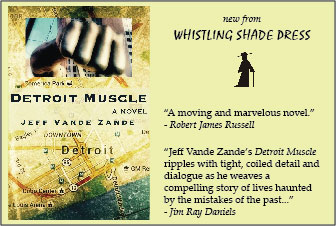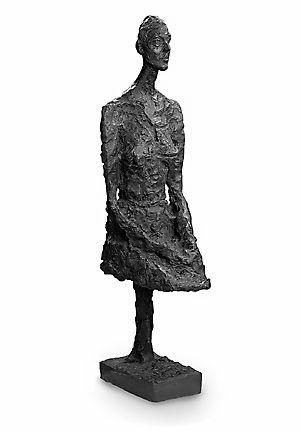
| <- Back to main page |

|
The author is assured that the statute of limitations on this Class G felony have long since run out [Wis. Stat. § 939.74] and so I am free to sing long and loud about it without fear of incriminating myself, or anyone else, as accomplices or accessories after the fact, including the editors of this magazine, or its readers.
In 1966, shortly after the death of Alberto Giacometti, the “most expensive sculptor in the world,” his thirty-one inch bronze figure, “Large Seated Woman”, grew legs in broad daylight and walked away from the Milwaukee Museum of Art. The theft was a classic acte gratuit, one of those riddles that preoccupied Giacometti’s friends, Jean-Paul Sartre, Jean Genet, and Simone de Beauvoir. This gratuitous act with no motive and no purpose was performed at the edge of freedom’s abyss where, as Sartre averred, the absurdity of life begins.
There was something about Giacometti, the bushy-haired Catholic prude, that attracted sticky fingers. Simone de Beauvoir liked to buy extra meals in restaurants and put them on his bill. In a kind of reverse theft, she stole bicycles and left them in his courtyard for laughs. Things disappeared from his studio all the time and hardly anyone who visited there didn’t leave without pinching something. His brother, Diego, reportedly made secret forgings of the artist’s work and accumulated a private stash of his own. Henri Matisse posed for a portrait prior to Giacometti casting a medallion of him and then the portrait turned up missing. Giacometti wondered how someone could have made off undetected with something so large. The culprit turned out to be none other than his best friend, novelist and playwright Jean Genet, one of only two people he trusted with a key to his studio. After the artist’s death Genet sold the painting to Giacometti’s brother and blamed its disappearance on Simone de Beauvoir.
It’s been said that Giacometti’s sculptures show what would be left of humanity if everything false were stripped away, leaving only a stick figure with a blob of bronze as a clueless face. This studied subtraction to arrive at man’s essence turns out to be precisely what made his sculptures so easy to copy. Robert Driessen, one of the most successful art forgers in the world, ran a $140-million-dollar industry forging at least 1,000 Giacomettis. He says it took him only thirty minutes to duplicate one. The larceny continued one more step. Driessen claims he was cheated out of eighty-percent of his asking prices by greedy agents and buyers. “It was very unfair,” he laments from his luxury yacht, hiding from authorities in Thailand.

My part in all this thievery involved an accomplice I will call Craig Tyler. We both came from affluent families reduced to penury, the death of a father in his case, divorce in mine. We met when I was a skinny high school freshman and he was an obese sophomore. There was nothing we had in common except for one thing: we were both social outcasts, grounds enough for a close friendship. I fed my mind on literature while he gorged himself on anything about war and weaponry.
The day he turned seventeen he got his mother’s permission to join the Marines. He left home a fearful fat kid and when he got out of boot camp he was thin as a saber and fluent in blood-curdling curses, all the more unsettling because he delivered them with such élan. We lost track of each other after that.
I went on to study philosophy at the University of Wisconsin, Milwaukee and was told by everyone that such a major was “worthless on the open market.” But I didn’t care about open markets, only the answers to ultimate questions. Cheap housing was not a problem then, so I stayed in a four-dollar-a-week sleeping room and feasted on rutabaga (seven cents a pound) cooked on a hot plate with bulgur doled from the county. Museums were free, college events were free, movies and plays were cheap and I could languish as long as I wanted in the university library. Everything was fine except for one thing: Vietnam. I had a student deferment but was in constant fear of losing it. One of my classmates foolish enough to drop out was immediately drafted and sent to Vietnam. He came back with one side of his head missing.
One day there was a knock on my door. It was Tyler. He’d just got back from Vietnam where he was kicked out of the Marines on a BCD (Bad Conduct Discharge). Since he had no place to stay he was happy to sleep on my floor (“at least there’s no snakes”) and share rations as well as war stories of such horror as to make me cling even tighter to that student deferment.
The term was not used yet but Tyler suffered from post-traumatic stress. After a few days in his company I began to develop pre-traumatic stress. Although he was no longer in Vietnam he was still in a jungle of his mind and the enemy was everywhere waiting to get him. He forced confrontations with people in cafes because they made noise when they ate and “gave away their position.” With a smile he kicked over furniture in bars and cleared countertops in one sweep. Once bullied as a kid, he now bullied the world. He went to jail a couple of times for disturbing the peace, but when he flashed his military ID and cited his service in Vietnam (then supported by 80% of the American public) his cases were continued and he was sent on his way with a pat on the back. The BCD never came up or didn’t matter.
Since we were old friends he reciprocated by accompanying me to cultural events like showings at the Milwaukee Art Museum, located, ironically, in a building known as the War Memorial. I was already familiar with Giacometti from Sartre’s essay in Situations, and after reading the artist’s obit in the paper I wanted to have a closer look at his “Large Seated Woman”, a work of “calculated indetermination.” It was the first work of art one saw upon entering the gallery, visible in an alcove halfway down the stairs to the lower level. As we stood before the pedestaled figure, floating in space like a genii upon a rug, I pointed out the way she presented what Sartre called “an insuperable distance” between herself and the viewer, that very distance being “the innermost nature of the object.” Tyler listened attentively. As we proceeded further into the gallery he took particular interest in works that depicted anything grotesque. A museum guard dutifully followed us around, a situation that stirred up some dangerous paranoia in Tyler, as if the guard were a Viet Cong following him down a jungle path. I suggested we retreat to the safety of a bar.
On the way out Tyler went to the men’s room and I went to the souvenir counter to buy a postcard of the Seated Woman, but there was no one at the register. I don't know if the clerk was in a staff meeting or on the toilet. I returned the postcard to the rack and left the building. Tyler rejoined me and we began to walk.
After a couple of steps he said, “Here,” and held up the Seated Woman by the neck as if he’d just bagged a rabbit. “My half of the rent.”
It was an easy theft of opportunity. Security was lax for a work of such importance. Ordinarily the presence of patrons would have been deterrence enough, but it was a weekday afternoon and the lobby was empty. There were no surveillance cameras then and the guards in the gallery could not see the alcove, which was monitored by whomever worked the gift counter—and that person was gone.
There was no time for pondering the value of action in life’s meaningless void. I snatched the bronze figure from his hand and was surprised at how light she was. Obviously hollow. I ran toward the museum not knowing what I was rushing into, like a green draftee stumbling toward a bunker in Quang Nam Province. If I was going to get caught, best to be caught returning her rather than taking her away. In the museum there was still no one at the gift counter nor anyone in the lobby. I went down the half level of steps to the alcove where the gnarly metal pedestal still sat and lowered the figure upon it. It slid up into her body from underneath with a hollow metallic scrape. Once replaced, she sat as before, floating in a plenitude of nothingness.
When I joined Tyler outside I expected police cars to veer in from all directions, but they did not. My hands were shaking and I was speechless, but he was calm as a glassy lagoon. “In the Marines they teach you how to travel light and steal what you need along the way. Be resourceful. If a jeep needs a tire, just walk into a warehouse and take one. Take the whole damn jeep if you have to. That’s how I got a flamethrower to roast up a couple a gooks tied to a tree.”
When he finally moved on to Boston, my room was full of staplers and toothpick dispensers, wastebaskets, typewriters, a swivel chair and an oxygen tank I talked him out of using to blow up a candy store. A few months later I heard that he was in a Massachusetts prison, but I never found out for what.
The war escalated and student deferments were abolished. Draft boards called up everyone and that included me. The FBI caught me as a draft dodger, but through a series of ruses I managed to finagle a coveted 4-F draft classification, thus escaping the death sentence that hung over every young man of military age in America. In all this turmoil and klepted clutter the theft and return of the Giacometti became a minor incident easy to forget.
In a 1957 interview Giacometti said, “A sculpture is not an object, it is an interrogation, a question, an answer.” So what’s an interrogation worth on the open market?
My hard-shell Baptist grandfather, who would have scoffed at such a thing as the existential arbitrariness of values, used to say, “First you steal a penny, then it’s a nickel, and then you’re robbing banks.” I might add to that, “Then you’re starting wars.” It was probably his advice more than Sartre and Beauvoir’s mauvaise foi that compelled me to back away from the abyss that afternoon and return Giacometti’s Seated Woman to her proper ontological locus. As far as I know the theft was never discovered. I am perhaps the only one of all the people connected to Giacometti’s many filched creations ever to return one. So little did I care about its value “on the open market” that only recently did I discover that the “Large Seated Woman” the War Memorial did so little to protect, and that resulted in my purloined affair with her that lasted all of thirty seconds, was subsequently valued by Southeby’s at between $5 and $7 million dollars.